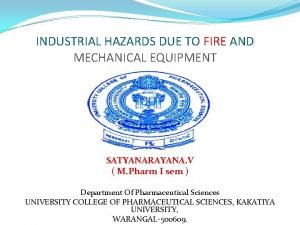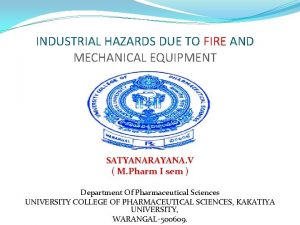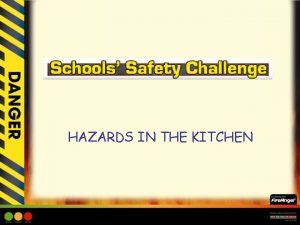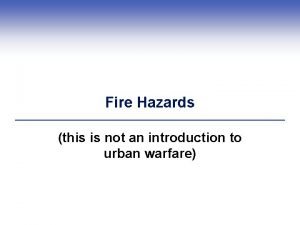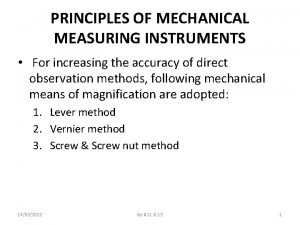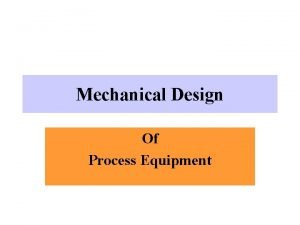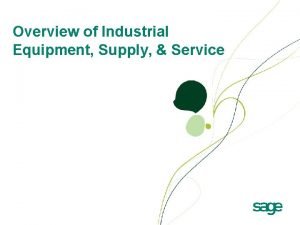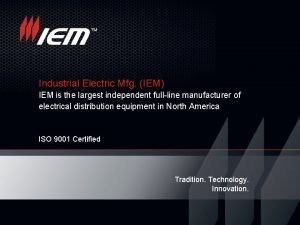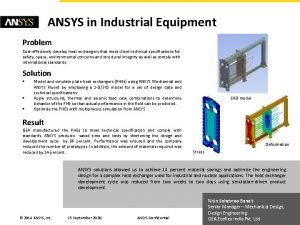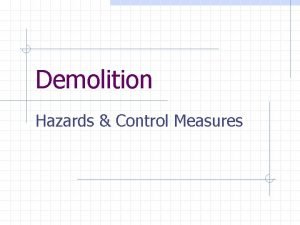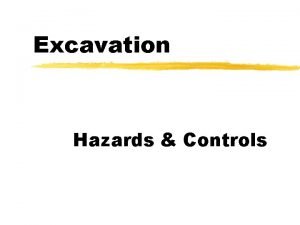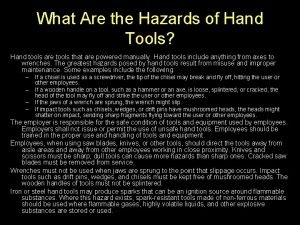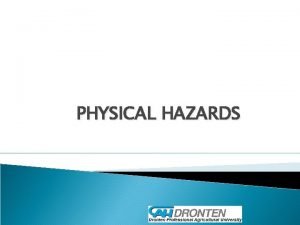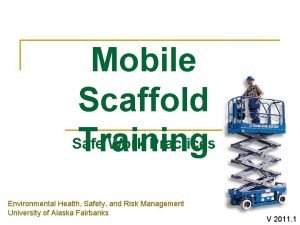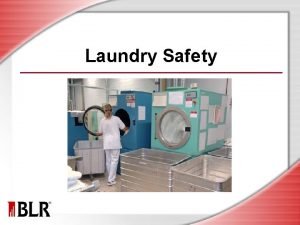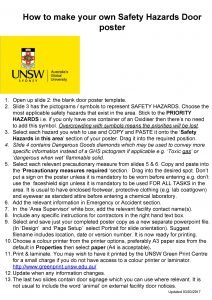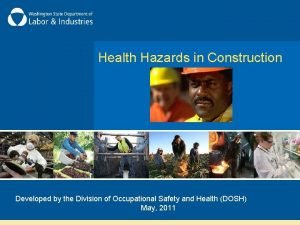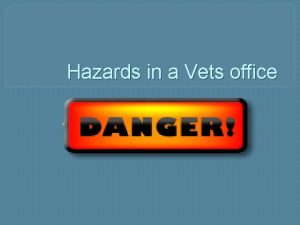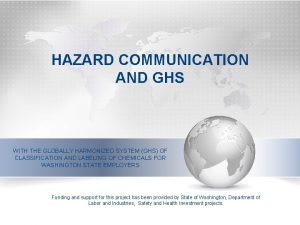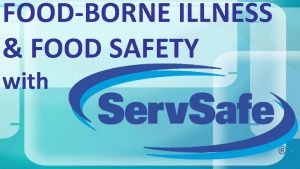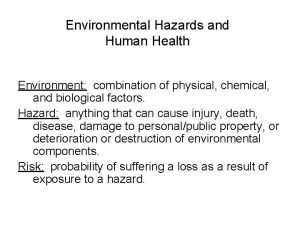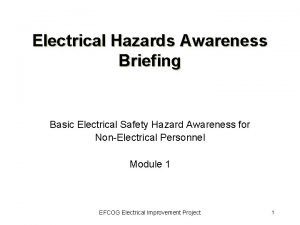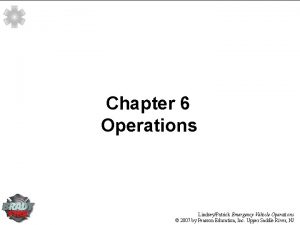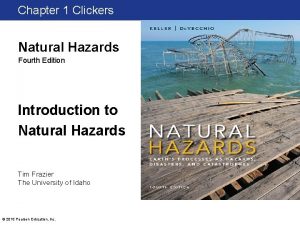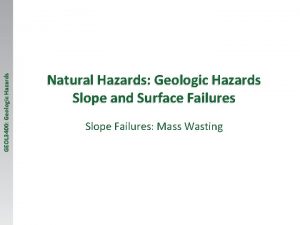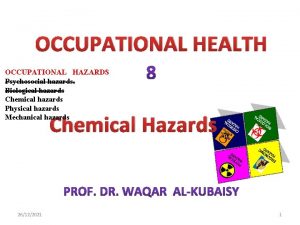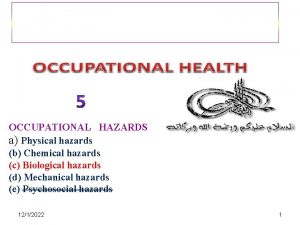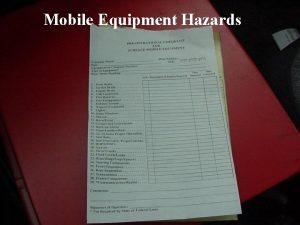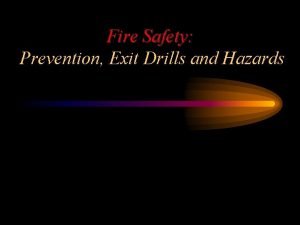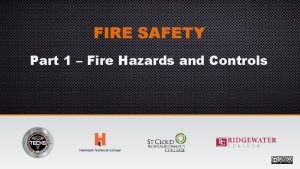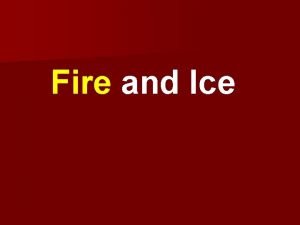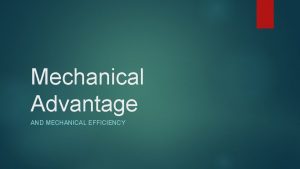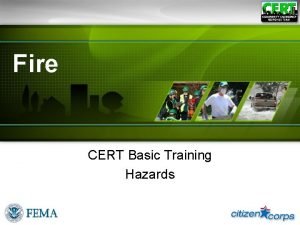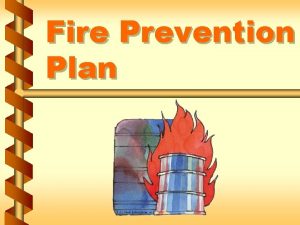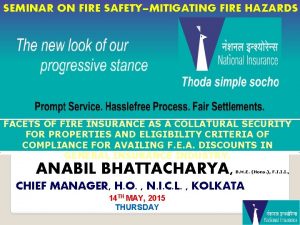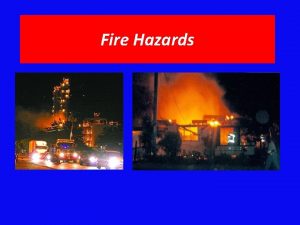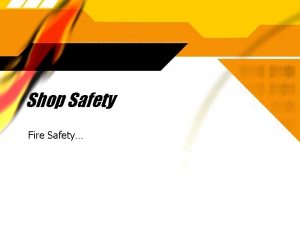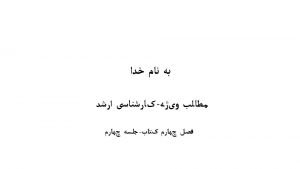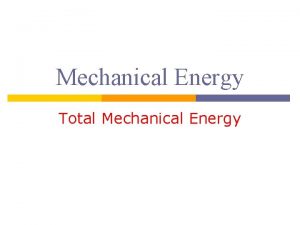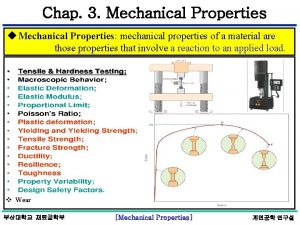INDUSTRIAL HAZARDS DUE TO FIRE AND MECHANICAL EQUIPMENT













































- Slides: 45

INDUSTRIAL HAZARDS DUE TO FIRE AND MECHANICAL EQUIPMENT SATYANARAYANA. V ( M. Pharm I sem ) Department Of Pharmaceutical Sciences UNIVERSITY COLLEGE OF PHARMACEUTICAL SCIENCES, KAKATIYA UNIVERSITY, WARANGAL-500609.

CONTENTS INTODUCTION Types of hazards in a pharmaceutical industry Fire Classification of fires Ø Classification of hazardous areas Ø Potential cause for a fire Ø Prevention of fire Ø Mechanical Hazards with equipment Safety aspects in the pharma industry Disaster management plan Conclusion References

Introduction HAZARD is a term associated with a substance that is likely to cause an injury in a given environment. INDUSTRIAL HAZARD is any condition produced by industries that may cause: Ø injury to a personnel, (or) Ø One which may lead to loss of property, products etc; (or) Ø A substance that might proove fatal to the personnel

TYPES OF HAZARDS IN AN INDUSTRY Fire Ø Chemicals Ø Electrical Mechanical Miscellanious Ø Pharmaceutical Ø Biological Ø Personnel Ø Environmental

CHEMICAL HAZARDS Ø Volatility of solvents Ø Flammability Ø Explosivity Ø Stability Ø Corrosivity Ø Reactivity Ø Radioactivity

ELECTRIC HAZARDS Ø BASED over protective devices Ø Short – circuit fault protectve device Ø Open circuit fault protective devices Ø Ratings and sizes of surge –protective capacitors

Measures to be taken Use of high quality electricals Electrical equipment maintanance Proper handling of chemicals CHEMICAL SAFETY CARDS Ø Experts Ø Retailer

CHEMICAL DATA SHEET �A chemical safety data sheet provides the following basic information about the chemical: �Identification : � Name of the substance or preparation � Name, address and telephone number of the company/supplier/undertaking �Composition and information on ingredients �Hazards identification �First-aid measures �Fire-fighting measures �Spillage, accidental release measures �Handling and storage �Exposure controls and personal protection

Physical and chemical properties Stability and reactivity Toxicological information Ecological information Disposal considerations Transport information National regulations and references Other information

Chemical safety data sheets are published under several names such as: INTERNATIONAL CHEMICAL SAFETY CARD, ICSC CHEMICAL SAFETY CARD CHEMICAL INFO-SHEET MATERIAL SAFETY DATA SHEET, MSDS PRODUCT SAFETY DATA SHEET HEALTH AND SAFETY DATA SHEET.

Miscellaneous hazards Ø Pharmaceutical Ø Biological Ø Personnel Ø Environmental

FIRE HAZARDS Fire: The self-sustaining process of rapid oxidation of a fuel which produces heat and light Ø Fire is an exothermic chemical reaction between oxygen and fuel at certain temperature. Three things essential for the combustion of fire are; Ø Fuel (any combustible material) Ø Oxygen (At concentrations above 23 % in air, the situation becomes dangerous due to the increased fire hazard) Ø Temperature

Classification of fires Most fires that occur will fall into one or more of the following categories Ø Class A: Fires involving ordinary combustible materials, such as paper, wood, and textile fibers, where a cooling, blanketing, or wetting extinguishing agent is needed. Ø Class B: Fires involving flammable liquids such as gasoline, thinners, oil-based paints and greases. Extinguishers for this type of fire include carbon dioxide, dry chemical* and halogenated agent types.

Class C: Fires involving energized electrical equipment, where a nonconducting gaseous clean agent or smothering agent is needed. The most common type of extinguisher for this class is a carbon dioxide exinguisher Class D: Fires involving combustible metals such as magnesium, sodium, potassium, titanium, and aluminum. Special dry powder* extinguishing agents are required for this class of fire, and must be tailored to the specific hazardous metal.

Class K: Fires involving commercial cooking appliances with vegetable oils, animal oils, or fats at high temperatures. A wet potassium acetate, low p. H -based agent is used for this class of fire.

Classification of hazardous areas Zone 0: an area in which a atmosphere is present continously or is present for long periods. Zone 1: an area in which a flammable atmosphere is likely to be present periodically or occasionally during normal operations. Zone 2: an area in which a flammable atmosphere is likely to be present peridically or occur in normal operations.

POTENTIAL CAUSE FOR A FIRE ØImproper design or layouts Ølack of proper work design process ØElectricity ØChemicals ØHousekeeping ØImproper Storage ØFlammable Liquids ØCombustible materials ØEquipment ØLack of proper ventilation ØCarelessness

Actions in the event of fire Fire detection Raising the alarm Calling the local fire brigade First aid – fire fighting practice evacuation

PREVENTION OF A FIRE Well planned design and layout Proper ventilated systems Chemical data sheets Proper training of personnel Proper maintenance of surroundings use of fire extinguishers, alarms , sensors, detectors Fire fighting equipment Sprinkler systems

Extinguishment Theory Removing Heat Removing Fuel Reducing Oxygen WILL Inhibit Chemical Chain Reaction

FIRE EXTINGUISHERS The fire extinguishing agents are classified into Ø Water and water based agents • portable extinguishers • soda acid extinguishers • antifreeze extinguishers • foam Ø Dry chemical Ø Carbon dioxide Ø Halon 1301( bromo tri fluoromethane) Ø Vaporizing liquid Ø Dry powders for combustible metals

FIRE EXTINGUISHERS Non-Magnetic stored pressure deionized water mist fire extinguisher Halotron 1 Fire extiguisher. ABC Dry chemical fire extinguisher K Class Wet chemical extinguisher. Carbon dioxide (CO 2) Portable fire extinguisher

Characteristics of extinguishers Water extinguisher 30 -40 ft. 60 sec. Dry chemical 5 -20 ft. 8 -25 sec. CO 2 extinguisher 3 -8 ft. 8 -30 sec.

“Quick-Check” Is It Ready To Use ? 1. Check the gauge. The pressure indicator should be in the green zone. (CO 2 extinguishers do not have pressure gauges. ) 2. The extinguisher should have a current inspection tag. 3. The pin and handle should be secured with a plastic tab seal. 4. The extinguisher and hose should be free of any visible damage.

The P. A. S. S. Method Aim the hose or nozzle. Pull the pin. Squeeze the lever. Sweep agent. the

FIRE EXTINGUISHERS �Dry Chemical - Works on class A, B, and C fires (Multipurpose). �Carbon Dioxide - Works on class B and C fires. �Water - Works on class A fires. �Foam - Works on class A and B fires. �Halogenated - Works on class A, B, and C fires. �Dry Powder - Works on class D fires. �Wet Chemical - Works on class K fires.

FIRE ALARMS

Fire sensors Smoke detector Spinkler systems Heat detectors

Mechanical hazards INTRODUCTION: Mechanical hazards may occur due to the large numbers and different designs of equipment, crowded workplace conditions and frequent interaction between workers and equipment Hazardous electrical, pneumatic and thermal energy must be released or controlled before working on active equipment and utilities Workers are protected from sources of hazardous energy by Ø Implementing lock out / tag out procedures. Ø Interlocked guards, control switches, emergency stop devices and operator training are important means of reducing mechanical hazards.

HAZARDS WITH MECHANICAL EQUIPMENT WAREHOUSING RAW MATERIAL WEIGHING GRANULATE PREPARATION TABLET & CAPSULE PRODUCTION SUPPOSITORY AND PESSARY PRODUCTION SOLUTION PREPARATION CONTAINER STERILIZATION OINTMENT PASTE CREAM GEL PRODUCTION CONTAINER FILLING INSPECTION CONTAINER FILLING FREEZE DRYING PACKAGING PALLETIZATION WAREHOUSING: FINISHED PRODUCTS SHIPMENT

WAREHOUSING WORK PHASE DESCRIPTION Incoming and out going goods store (raw materials, excipients, labels, printed information materials) The raw materials and excipient store is generally located close to the production areas. Products are stored on multi-level racks and shelves. Manually operated trolleys and electrical pallet handlers are used to move boxes/containers. EXPECTED INJURIES Muscular-skeletal complaints. Cutting injuries

Electronic and/or mechanical weighing scales The pharmaceutical industry uses the classic single/twin platter mechanical scales. The more modern electronic scales are characterised by a metal box enclosing the apparatus and by a weighing system generally including a platter. Electronic scales are fitted with local powder/dust exhaust devices or laminar flow exhaust hoods. RISK FACTORS: Exposure to dust EXPECTED INJURIES: Allergic asthma, contact dermatitis

Work performed in the presence of moving machinery parts DESCRIPTION Manual cleaning of certain machine may entail the operator being snagged, dragged or crushed by the machine’s parts in motion. By way of an example, an operator may clean a mixer/blender by pouring the cleaning fluid in the vat and starting the machine in order to better clean the internal surfaces. Other operators may accidentally start the machine while staff is cleaning the machine’s internal parts. EXPECTED INJURIES Lesions and bruises. PREVENTIVE MEASURES Hazardous zones must be shielded by fixed guards or fitted with interlocking safety devices to reduce the risk of operators being snagged and dragged. Machinery must be fitted with emergency shut down and accidental start-up lockout devices such as safety devices blocking machine start up when power is restored after a temporary blackout.

PROCESSING OF SEMI-SOLID PHARMACEUTICAL FORMS RISK FACTORS: Fatiguing tasks and work postures DESCRIPTION Careful cleaning of plant systems especially where processing of semisolid pharmaceutical forms particularly rich in lubricating agents such as suppositories, ovules and ointments takes place, require manual operations involving fatiguing tasks and anomalous work postures. EXPECTED INJURIES Muscular-skeletal complaints. PREVENTIVE MEASURES - Consider the feasibility of employing built-in, closed-cycle automatic washing and/or sterilization systems (cleaning in place). - Accurate task organization and operator information and training.

Ø Ø Ø Ø Ø GRANULATE PREPARATION EQUIPMENT AND MACHINERY Miller/grinders Compactor Twin Whisk Blender Planetary or crown wheel Blender Rotating Tub Blender Fluid Bed Granulator-Dryer Dynamic Tunnel Dryer System Dynamic Revolving Drum Dryer System Vacuum Dryers RISK FACTORS : Exposure to dust DESCRIPTION Operators may be exposed to dust during miller/grinder loading/unloading, compacting, blending and granulation operations. ESTIMATE Field assays have yielded ambient air dust concentration levels ranging from 342 to 3. 462 µg/m 3 in the blender shop, from 307 to 1. 884 µg/m 3 in the granulator shop. EXPECTED INJURIES Allergic asthma, contact dermatitis. Specific pharmacological effects due to active principles. PREVENTIVE MEASURES Use of completely automated load/unload systems. Use of protective hoods fitted with absolute filters.

EXPOSURE TO NOISE DESCRIPTION The sources of noise in this work phase are: miller/grinders, compactors, blenders and granulators. Notwithstanding the use of sound dampening devices, noise levels may be quite high. EXPECTED INJURIES Continuous exposure to medium-high noise levels may cause hearing injuries (noiseinduced hypoacusia) and extra-hearing complaints. Injuries and complaints may result also from exposure to noise levels lower than the thresholds for which legislation prescribes the use of specific preventive measures. In addition to communication and work performance-related complaints, the following disorders may also arise: cardiovascular effects (high blood pressure, etc. ); psychic disorders (asthenia, irritability, depression, insomnia); digestive tract disorders. PREVENTIVE MEASURES Preventive measures established in cases of employee noise exposure exceeding 80 d. B(A). Decrease the exposure time

MANUAL LOAD HANDLING DESCRIPTION Machine hopper loading operations in this phase may be performed manually. EXPECTED INJURIES Muscular-skeletal complaints PREVENTIVE MEASURES Use of mechanical/electrical handling devices or automated loading systems. Two operator handling of heavy loads. Manual load handling is permitted for loads up to 30 kgs. (males) and 25 kgs. (females). Handling of loads exceeding these limits shall be performed using appropriate devices and/or shall be performed by two operators. Operator information and training.

OINTMENT, PASTE, CREAM AND GEL PRODUCTION Ø Ø Ø EQUIPMENT AND MACHINES Turbo-emulsifier (blender-homogeniser) Manually operated trolleys Bulk storage tanks Risk factors: Exposure to dust DESCRIPTION Loading active principles into the emulsifiers is typically performed manually. Operators insert a suction nozzle connected to the emulsifier into the bins containing the active principles or excipients. ESTIMATE: Field data typically reports that an operator performs approximately two active principle and excipient emulsifier loading cycles per 8 hour working shift. Loading operations total 90 minutes resulting in 0, 76 mg/m 3. mean operator dust exposure levels. TLV-TWA threshold values reported by firms are 0. 5 mg/m 3 for active principles and 10 mg/m 3 for gelling excipients. EXPECTED INJURIES Active principle-specific induced injuries. PREVENTIVE MEASURES - Use of automated loading systems

Container Filling And Packaging EQUIPMENT AND MACHINES Ø Manually operated trolleys Ø Plastic stopper vibrator Ø Tube Filler Ø Packaging machine Ø Labelling machines Ø Boxing machines

Contd… Risk factors: Manual load handling ESTIMATE: Load handling data furnished by a drug company may be broken down as follows: - empty tube feed: package weight 5 kgs, feed frequency 3/min. ; - filled tube transfer: weight 10. 8 kgs, frequency 2/min. ; - labeller feed: weight 7 kgs, frequency 1/min. EXPECTED INJURIES: Muscular-skeletal complaints. PREVENTIVE MEASURES Use of electric powered or mechanical devices or automated systems. Manual load handling operations are limited to loads up to 30 kgs for men and 25 kgs for women. Heavier loads shall be handled employing appropriate means and/or shall be performed by two operators.

SAFETY ASPECTS IN THE PHARMA INDUSTRY Standard operating procedures Handling of hazardous materials Water supply and drainage Floors and floor coverings Emergency exits Back up plan if anything goes wrong Specially trained personnel Health polices and insurance Written procedures Safety audits Risk analysis Appropriate training and education to employee Regular monitoring of workplace Written documentation of policies Create awareness of the environment Involvement of the personnel Contingency plan

DISASTER MANAGEMENT PLAN � Disaster management plan is essential as it: Ø Reduces the amount of thinking time required after the incident occurred Ø Contains the incident and minimizes the extent of the damage to the resources and business. Ø Reduces the conduct of disaster to a set of predetermined rules and a system of orderly procedure to make orderly and rational § The success in disaster management depends on : Ø Ø Ø Reliable early detection Careful planning Efficient personnel Proper training of all personnel concerned Problem free communication

CONCLUSION From the previous discussion it is clear that the safety aspects must be considered by the pharmaceutical industry not only in the interest of the employees or property but also in terms of the neighboring environment as well. The source of possible hazards , risk analysis, control procedures , preventive measures &contingency plan are the main five essentials for ensuring a complete work atmosphere in the industry

REFERENCES �G. D. Muir, ”Hazards in Chemical Industries”, 2 nd edition. �Reigel’s Handbook of Industrial Chemistry, 9 th edition. �James Sward Brick, James C. Boylan, Encyclopedia of Pharmaceutical Technology, volume-4. �www. fda. gov �www. friesnoop. com �www. pubmed. com �www. agricum. com �www. teoma. com �www. altavista. com

THANK YOU
 Fire hazards in pharmaceutical industry
Fire hazards in pharmaceutical industry Mechanical hazards in industry
Mechanical hazards in industry Kitchen hazards picture
Kitchen hazards picture Mechanical energy hazards
Mechanical energy hazards Stage of fire
Stage of fire Physical hazards
Physical hazards Figura geometrica con i lati disuguali
Figura geometrica con i lati disuguali Procedural due process vs substantive due process
Procedural due process vs substantive due process Pentacosiomedimni cavalieri zeugiti teti
Pentacosiomedimni cavalieri zeugiti teti Conservazione del moto
Conservazione del moto Mechanical measuring instruments
Mechanical measuring instruments Mechanical design of process equipment
Mechanical design of process equipment Ship fire fighting equipment
Ship fire fighting equipment Actual mechanical advantage vs ideal mechanical advantage
Actual mechanical advantage vs ideal mechanical advantage Dynamics 365 industrial equipment manufacturing
Dynamics 365 industrial equipment manufacturing Industrial equipment supply
Industrial equipment supply Industrial electric mfg
Industrial electric mfg Phes industrial equipment supply
Phes industrial equipment supply Reichstag fire who was the fire starter
Reichstag fire who was the fire starter Damper fire alarm
Damper fire alarm Fire hose reel signage standards
Fire hose reel signage standards Rwi are
Rwi are Race fire safety
Race fire safety Slip trip fall hazards
Slip trip fall hazards Cdm demolition
Cdm demolition Excavation hazards and controls
Excavation hazards and controls Workplace hazards and risks
Workplace hazards and risks Understanding hazards and risks
Understanding hazards and risks Hazard of hand tools
Hazard of hand tools Primary volcanic hazards
Primary volcanic hazards Example for physical hazard
Example for physical hazard International signs drivers ed
International signs drivers ed Example of biological hazard
Example of biological hazard Radiation hazards definition
Radiation hazards definition Physical hazard example
Physical hazard example Mobile scaffold accident
Mobile scaffold accident Laundry objectives
Laundry objectives Greenprint unsw
Greenprint unsw Biological hazards in construction
Biological hazards in construction Chemical hazards in a veterinary clinic
Chemical hazards in a veterinary clinic Ghs pictogram depicts which hazard
Ghs pictogram depicts which hazard The three types of hazards that make food unsafe are
The three types of hazards that make food unsafe are Environmental physical hazards
Environmental physical hazards Hazard
Hazard Darkness conceals hazards such as
Darkness conceals hazards such as Natural hazards 4th edition
Natural hazards 4th edition
